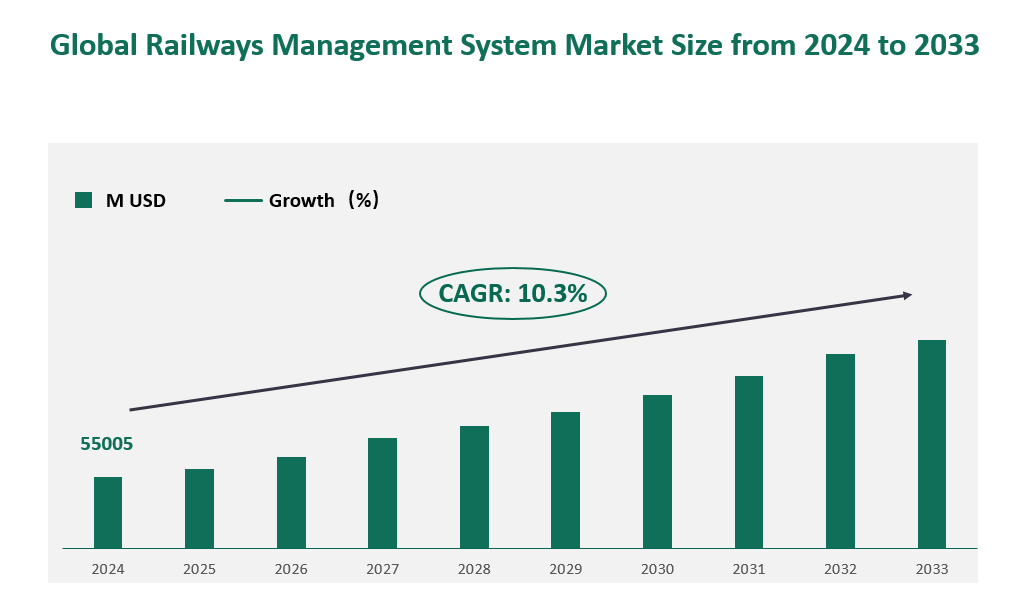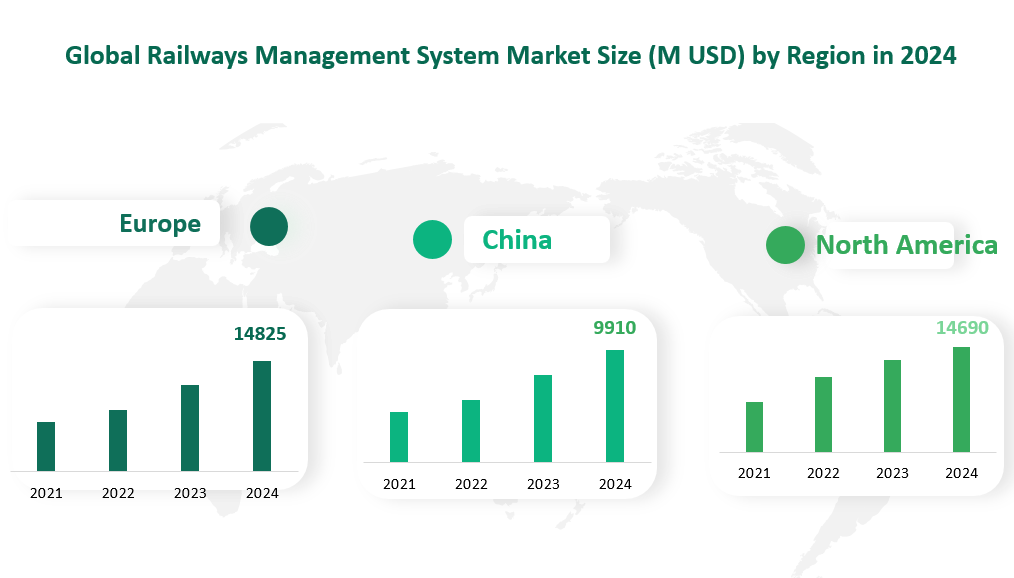1 Global Railways Management System Market Size (Value) and CAGR (2024-2033)
In 2024, the global Railways Management System market was valued at USD 55005 million, with a CAGR of 10.3% from 2024 to 2033.
A Railways Management System (RMS) is a comprehensive solution that integrates various technologies and processes to optimize railway operations.
Figure Global Railways Management System Market Size (M USD) and CAGR 2024-2033

2 Railways Management System Market Drivers
The Railways Management System (RMS) market is experiencing significant growth, driven by several key factors that are reshaping the global transportation landscape. One of the primary drivers is the increasing urbanization and population growth, particularly in emerging economies. As cities expand and populations grow, the demand for efficient, reliable, and sustainable transportation solutions also increases. Railways, as a mass transit solution, are seen as a crucial component in addressing these needs, thereby driving the adoption of advanced railway management systems.
Technological advancements, especially in the areas of the Internet of Things (IoT), cloud computing, and digitalization, are also playing a pivotal role in the growth of the RMS market. These technologies enable real-time monitoring, predictive maintenance, and enhanced operational efficiency, making railway systems safer and more reliable. For instance, IoT sensors can provide real-time data on train locations and conditions, while cloud-based systems allow for centralized management and analysis of this data.
Government support and regulatory policies are another significant driver. Many governments around the world are investing heavily in railway infrastructure to promote economic growth and sustainable transportation. Initiatives such as the European Union’s push for the European Railway Traffic Management System (ERTMS) aim to standardize and modernize railway operations across the continent. Similarly, countries like China and India are investing billions in expanding their high-speed rail networks, driving the need for advanced management systems.
3 Railways Management System Market Restraints
Despite the significant growth potential, the Railways Management System market faces several challenges and restraints that could hinder its expansion. One of the primary challenges is the high initial cost associated with the implementation of advanced railway management systems. The expenses involved in financing railway management projects, including the installation of field-level equipment, replacement of aging infrastructure, and integration of new systems with existing ones, can be prohibitive. These high costs can limit the adoption of RMS technologies, particularly in regions with limited financial resources.
Another significant challenge is the complexity of integrating new systems with existing legacy infrastructure. Railway management systems are often composed of various technical elements that need to be configured and integrated seamlessly. However, traditional systems may not be compatible with new technologies due to protocol and rule differences, making integration difficult and costly. This complexity can delay the implementation of RMS solutions and increase overall project costs.
4 Global Railways Management System Market Size by Type in 2024
The RMS market can be broadly categorized into two primary types: On-Premise Systems and Cloud-Based Systems. In 2024, On-Premise Systems are expected to dominate the market with a projected value of $35,103 million, accounting for approximately 63.82% of the total market share. These systems are traditional railway management solutions that are installed and operated within the premises of railway organizations. They offer high levels of control and security, making them a preferred choice for many railway operators, especially in regions with strict data privacy regulations. On-Premise Systems are particularly prevalent in North America and Europe, where legacy systems are deeply integrated into the operational framework. These systems are used for critical applications such as traffic management, operation management, and infrastructure monitoring.
Cloud-Based Systems are rapidly gaining traction due to their flexibility, scalability, and cost-effectiveness. In 2024, the market for Cloud-Based Systems is projected to reach $19,901 million, representing approximately 36.18% of the total market share. These systems leverage cloud computing technologies to provide real-time data processing and analytics, enabling railway operators to optimize their operations and enhance decision-making. Cloud-Based Solutions are particularly beneficial for small and medium-sized railway operators who may not have the resources to invest in large-scale on-premise systems. They are also ideal for applications such as predictive maintenance, where real-time data analysis is crucial.
Table Global Railways Management System Market Size by Type in 2024
Type | Market Size (M USD) 2024 | Market Share 2024 |
On Premise | 35103 | 63.82% |
Cloud Based | 19901 | 36.18% |
5 Global Railways Management System Market Size by Application in 2024
In 2024, the RMS market is segmented into several key applications, each addressing specific operational needs of railway systems. Traffic Management is a dominant application, with a projected market size of 18,990 million USD. This segment focuses on optimizing train movements through real-time tracking, automated scheduling, and conflict resolution algorithms, ensuring smooth operations and reducing delays. Operation Management follows closely, valued at 13,124 million USD, encompassing crew management, maintenance scheduling, and resource allocation. These systems are essential for the day-to-day functioning of railway networks, ensuring efficiency and reliability.
Power Supply Management, valued at 2,344 million USD, is critical for maintaining the operational integrity of railway systems. This segment includes technologies for monitoring and controlling power distribution, optimizing energy usage, and minimizing downtime. Infrastructure Management, with a market size of 9,665 million USD, involves monitoring and maintaining physical railway assets such as tracks, signals, and stations. These systems provide real-time data on asset conditions, enabling proactive maintenance and enhancing safety.
Table Global Railways Management System Market Size by Application in 2024
Application | Market Size (M USD) 2024 | Market Share 2024 |
Traffic Management | 18990 | 34.52% |
Operation Management | 13124 | 23.86% |
Power Supply Management | 2344 | 4.26% |
Infrastructure Management | 9665 | 17.57% |
Others | 10881 | 19.78% |
6 Global Railways Management System Market Size by Region in 2024
North America is a significant market, valued at $14690 million in 2024. This region benefits from strong regulatory support and high investment in infrastructure modernization. The United States and Canada are key markets, with a focus on improving operational efficiency and safety through advanced technologies such as cloud-based solutions and IoT.
Europe is the largest market, with a projected size of $14825 million in 2024. The European Union’s push for the European Railway Traffic Management System (ERTMS) is a major driver, promoting interoperability and modernization across the region. Countries such as Germany, France, and the UK are leaders in adopting digital technologies and smart railway solutions, enhancing safety and efficiency.
China is experiencing rapid growth, with a market size of $9910 million in 2024. The region is also witnessing the adoption of advanced technologies such as IoT, AI, and big data analytics to enhance railway operations.
Figure Global Railways Management System Market Size by Region in 2024

7 Major Players in Global Railways Management System Market
7.1 Hitachi
Company Profile: Hitachi, Ltd. is a Japanese multinational conglomerate headquartered in Tokyo, Japan. Established in 1910, Hitachi operates in various sectors, including information technology, construction machinery, and railway systems. The company is known for its innovative technologies and commitment to sustainable development.
Business Overview: Hitachi’s business portfolio spans a wide range of industries, with its railway division focusing on developing advanced systems for traffic management, operation management, and infrastructure monitoring. Hitachi’s RMS solutions are designed to provide comprehensive support for all railway operations, ensuring seamless communication and efficient management.
Railways Management System Introduction: Hitachi’s RMS solutions include traffic planning, operation management systems, power supply and infrastructure management, and maintenance support. These systems are designed to improve ridership convenience, enhance operational efficiency, and ensure safety through real-time monitoring and automated adjustments. Hitachi’s systems also support both driver-only and driverless operations, making them versatile for various railway applications.
Recent Financial Data: In the most recent year, Hitachi’s revenue in the RMS business was $3,354 million, with a gross margin of 64.60%.
7.2 Siemens
Company Profile: Siemens AG is a German engineering and manufacturing company headquartered in Munich, Germany. Established in 1847, Siemens is a global leader in electrification, automation, and digitalization. The company operates in various sectors, including energy, healthcare, and transportation.
Business Overview: Siemens’ railway division focuses on providing comprehensive solutions for railway management, including operation management systems, traffic management, and signaling systems. Siemens’ RMS solutions are designed to optimize the entire maintenance process, enhance operational safety, and improve the availability of railway systems.
Railways Management System Introduction: Siemens’ RMS solutions include features such as facilities and vehicle management, train tracking, and automated control of maintenance processes. These systems are designed to provide real-time data and analytics, enabling railway operators to make informed decisions and enhance overall operational efficiency. Siemens’ systems are also compliant with international standards, ensuring interoperability and reliability.
Recent Financial Data: In the most recent year, Siemens’ revenue in the RMS business was $3,120 million, with a gross margin of 62.37%.
7.3 Wabtec
Company Profile: Wabtec Corporation is a leading supplier of critical components, locomotives, services, signaling, and logistics systems to the global rail industry. Headquartered in Wilmerding, Pennsylvania, USA, Wabtec was established in 1994. The company is known for its commitment to safety, innovation, and efficiency.
Business Overview: Wabtec’s business focuses on driving the digital transformation of transportation through advanced technologies and services. Wabtec’s RMS solutions are designed to enhance the efficiency and reliability of railway operations, providing comprehensive support for traffic management, operation management, and infrastructure monitoring.
Railways Management System Introduction: Wabtec’s RMS solutions include advanced technologies such as real-time train tracking, automated scheduling, and predictive maintenance. These systems are designed to optimize railway operations, reduce downtime, and enhance safety. Wabtec’s solutions are also designed to be scalable and customizable, making them suitable for various railway applications.
Recent Financial Data: In the most recent year, Wabtec’s revenue in the RMS business was $1,630 million, with a gross margin of 69.21%.

